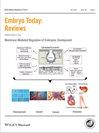Pamela V. Tran, Madhulika Sharma, Xiaogang Li, James P. Calvet
下载PDF
{"title":"Developmental signaling: Does it bridge the gap between cilia dysfunction and renal cystogenesis?","authors":"Pamela V. Tran, Madhulika Sharma, Xiaogang Li, James P. Calvet","doi":"10.1002/bdrc.21065","DOIUrl":null,"url":null,"abstract":"<p>For more than a decade, evidence has accumulated linking dysfunction of primary cilia to renal cystogenesis, yet molecular mechanisms remain undefined. The pathogenesis of renal cysts is complex, involving multiple cellular aberrations and signaling pathways. Adding to this complexity, primary cilia exhibit multiple roles in a context-dependent manner. On renal epithelial cells, primary cilia act as mechanosensors and trigger extracellular Ca<sup>2+</sup> influx in response to laminar fluid flow. During mammalian development, primary cilia mediate the Hedgehog (Hh), Wnt, and Notch pathways, which control cell proliferation and differentiation, and tissue morphogenesis. Further, experimental evidence suggests the developmental state of the kidney strongly influences renal cystic disease. Thus, we review evidence for regulation of Ca<sup>2+</sup> and cAMP, key molecules in renal cystogenesis, at the primary cilium, the role of Hh, Wnt, and Notch signaling in renal cystic disease, and the interplay between these developmental pathways and Ca<sup>2+</sup> signaling. Indeed if these developmental pathways influence renal cystogenesis, these may represent novel therapeutic targets that can be integrated into a combination therapy for renal cystic disease. <b>Birth Defects Research (Part C) 102:159–173, 2014.</b> © <b>2014 Wiley Periodicals, Inc.</b></p>","PeriodicalId":55352,"journal":{"name":"Birth Defects Research Part C-Embryo Today-Reviews","volume":"102 2","pages":"159-173"},"PeriodicalIF":0.0000,"publicationDate":"2014-05-26","publicationTypes":"Journal Article","fieldsOfStudy":null,"isOpenAccess":false,"openAccessPdf":"https://sci-hub-pdf.com/10.1002/bdrc.21065","citationCount":"25","resultStr":null,"platform":"Semanticscholar","paperid":null,"PeriodicalName":"Birth Defects Research Part C-Embryo Today-Reviews","FirstCategoryId":"1085","ListUrlMain":"https://onlinelibrary.wiley.com/doi/10.1002/bdrc.21065","RegionNum":0,"RegionCategory":null,"ArticlePicture":[],"TitleCN":null,"AbstractTextCN":null,"PMCID":null,"EPubDate":"","PubModel":"","JCR":"Q","JCRName":"Medicine","Score":null,"Total":0}
引用次数: 25
引用
批量引用
Abstract
For more than a decade, evidence has accumulated linking dysfunction of primary cilia to renal cystogenesis, yet molecular mechanisms remain undefined. The pathogenesis of renal cysts is complex, involving multiple cellular aberrations and signaling pathways. Adding to this complexity, primary cilia exhibit multiple roles in a context-dependent manner. On renal epithelial cells, primary cilia act as mechanosensors and trigger extracellular Ca2+ influx in response to laminar fluid flow. During mammalian development, primary cilia mediate the Hedgehog (Hh), Wnt, and Notch pathways, which control cell proliferation and differentiation, and tissue morphogenesis. Further, experimental evidence suggests the developmental state of the kidney strongly influences renal cystic disease. Thus, we review evidence for regulation of Ca2+ and cAMP, key molecules in renal cystogenesis, at the primary cilium, the role of Hh, Wnt, and Notch signaling in renal cystic disease, and the interplay between these developmental pathways and Ca2+ signaling. Indeed if these developmental pathways influence renal cystogenesis, these may represent novel therapeutic targets that can be integrated into a combination therapy for renal cystic disease. Birth Defects Research (Part C) 102:159–173, 2014. © 2014 Wiley Periodicals, Inc.
发育信号:它是否在纤毛功能障碍和肾膀胱发生之间架起了桥梁?
十多年来,越来越多的证据表明原发性纤毛功能障碍与肾膀胱形成有关,但分子机制仍不明确。肾囊肿的发病机制复杂,涉及多种细胞畸变和信号通路。增加了这种复杂性,初级纤毛表现出多种作用在上下文依赖的方式。在肾上皮细胞,初级纤毛作为机械传感器和触发细胞外Ca2+内流响应层流流体。在哺乳动物发育过程中,初级纤毛介导Hedgehog (Hh)、Wnt和Notch通路,控制细胞增殖、分化和组织形态发生。此外,实验证据表明肾脏的发育状态强烈影响肾囊性疾病。因此,我们回顾了Ca2+和cAMP(肾囊形成的关键分子)在初级纤毛上的调控证据,Hh、Wnt和Notch信号在肾囊性疾病中的作用,以及这些发育途径和Ca2+信号之间的相互作用。事实上,如果这些发育途径影响肾囊性疾病的发生,这些可能代表了新的治疗靶点,可以整合到肾囊性疾病的联合治疗中。出生缺陷研究[C](2):159 - 173, 2014。©2014 Wiley期刊公司
本文章由计算机程序翻译,如有差异,请以英文原文为准。

 求助内容:
求助内容: 应助结果提醒方式:
应助结果提醒方式:


